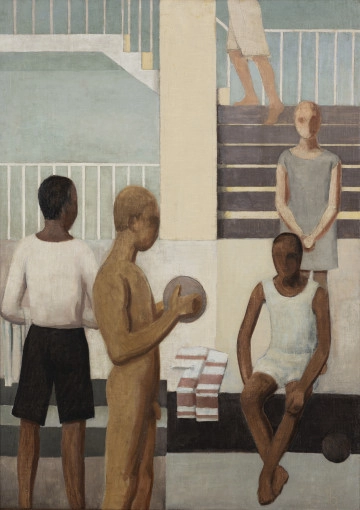
Work; Work created human
około 1950
National Museum in Szczecin
Part of the collection: European classics of modernity
Georg Kolbe was the son of the master painter Theodor Emil Kolbe. Between 1893 and 1894, he studied at the School of Arts and Crafts in Dresden, but already in 1895, he decided to move to Munich. There he initially enrolled in the private courses of Simon Hollosy, but due to financial difficulties he transferred to the Academy of Fine Arts there, first to the class of Gabriel von Hackl and then to Otto Seitz. In 1897, he went to Paris for a few months, where he studied at the Académie Julian. Between 1898 and 1901 he stayed in Rome, coming into contact with August Gaul and August Kraus, and especially Louis Tuaillon, who convinced Kolbe to take up sculpture. In 1909, the artist took part in the Paris Autumn Salon and visited the atelier of Auguste Rodin there. A decade later Kolbe was admitted to the Prussian Academy of Art, appointed the president of the Free Secession, and honoured with the title of professor. His sculptures of the time, with rough surfaces refracting light in the manner of Rodin's works, evoked associations with the art of the friendly Expressionists. A trip to Greece intensified his interest in classical statuary sculpture. Despite the increasing number of Kolbe's heroic statues, the new Nazi government's attitude to the style represented by the artist was ambivalent. Some of his works were removed from public space after 1933, but new commissions appeared. These included the statue of a resting athlete adorning the courtyard of the central sports complex in Berlin-Charlottenburg, where the 11th Summer Olympics were held in 1936. The Szczecin statue is a reduced version of this composition.
Szymon Piotr Kubiak
Author / creator
Dimensions
cały obiekt: height: 27,5 cm, width: 48 cm
Object type
sculpture
Creation time / dating
Creation / finding place
Identification number
Location / status

Gorełówna Maria
około 1950
National Museum in Szczecin

Bernhardt, Friedrich
1931
National Museum in Szczecin

nieznane
Castle Museum in Łańcut
DISCOVER this TOPIC
National Museum in Szczecin
DISCOVER this PATH
Educational path
0/500

We use cookies to make it easier for you to use our website and for statistical purposes. You can manage cookies by changing the settings of your web browser. More information in the Privacy Policy.
We use cookies to make it easier for you to use our website and for statistical purposes. You can manage cookies by changing the settings of your web browser. More information in the Privacy Policy.
Manage cookies:
This type of cookies is necessary for the website to function. You can change your browser settings to block them, but then the website will not work properly.
WYMAGANE
They are used to measure user engagement and generate statistics about the website to better understand how it is used. If you block this type of cookies, we will not be able to collect information about the use of the website and we will not be able to monitor its performance.